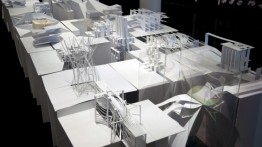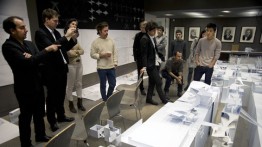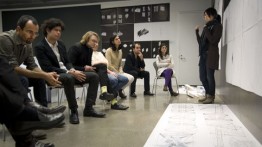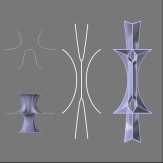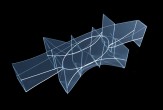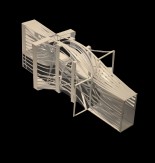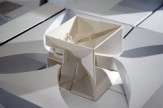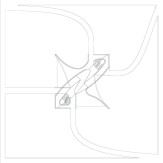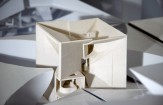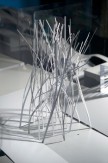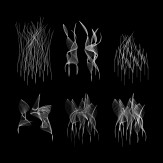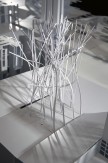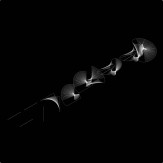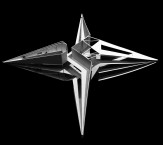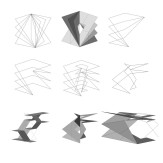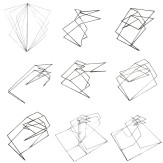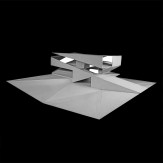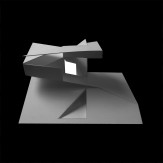Selected Undergraduate Design Studio Projects--Design II, Fall 2011
FALL 2011
Professors Pablo Lorenzo-Eiroa, Katerina Kourkoula, James Lowder
Enfolding the Expanded Field: Cartopological Space
Post-structuralist canons, on the other hand, relate to a reactionary criticism of the modernist paradigm of universality, which demanded the reconsideration of universal order and the generic container space in regards to the role of the place and the territory. Architecture incorporated a new philosophy, displacing its canonical relationship between contained space and ground. By assimilating the logic of space with that of the place and the territory, architecture resolved in the canonical thickening of the ground as an inhabitable surface (K. Forster), its new tectonic. After a few decades of experimenting with landscape-buildings, this process culminated with the autonomy of the vectorial surface. This disciplinary expansion based on the aesthetic of surface continuity evolved most recently into the emergence of spatial warping (A. Vidler), which provided new conditions for topology.
Part of this scenario left only two opposite alternatives: the reconfiguration of neomodernist boxes ignoring the displacement of the discipline by post-structuralist theories and post-structuralist blobs ignoring the presence of types and stable structures. This studio proposed to transcend this pendulum opposition between the establishment of a renaissance and its baroque displacement (H. Wölfflin).
Students studied the constitution of form through the development of source codes and systems that striate them. Considering representation as a critical creative moment where questions become problems to work with, visual logic functions as the recognition of formal systems. Critiquing oppositions between structure, embodiment and perception, students were asked to investigate implicit conflicts between referential structures and the intrinsic quality of representation through perception, materials and the presence of the body, which both infer and displace metaphysical notions of structure.
Structures and typologies were activated and deconstructed both top-down and bottom up through multiple definitions of topological displacements: topology as a way of resisting predetermination; topology as relative forces, or as degree deformations; topology as the topo-logos or the logic of the place; non-Euclidean geometric topology of bi-continuous surface deformation; topologies as immersive experiential space.
The enfolding of contemporary canons to revisit architecture limits, proposes the institution of a state of suspension that demands the recognition of a hybrid transitory space. Therefore a space historically suspended between a potential topological surface-space and its absolute stable referential Cartesian coordinate system. This space is defined as Cartopological.
The Design II studio concluded with the development of an un-house for two individuals.
<BACK TO SELECTED UNDERGRADUATE DESIGN STUDIO PROJECTS
Projects
-

Design II Fall 2011 - House
-
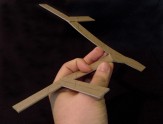
Design II Fall 2011 - House
-
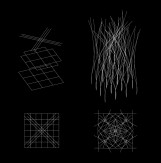
Design II Fall 2011 - House
-
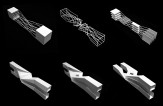
Design II Fall 2011 - House for Two
-
Design II Fall 2011 - The Unhouse
-
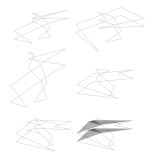
Design II Fall 2011 - Un-House
Back
Design II Fall 2011 - House
John Angelo Alonzo
Design II Fall 2011 - House
House
Henry Barrett
Through vectorial forces, this project explores how a point can become a plane within a nine square matrix. The house evolved out of a series of overlapping and intersecting vectorial spaces that evolve from a point on one end to a plane at the opposite. The point to plane condition explores a space that intersects ideas in plan and section in an equal manner.
Design II Fall 2011 - House
The Un-House
Phong Nguyen
This "un-house" emerges vertically from the intersected points of the nine square grid, creating gestural lines that merge into various bay grid systems. The members approach a state of chaos as they extend away from the ground plane towards infinity. The un-house asserts an alternative reading of anti-domestic inhabitation through a juxtaposition between stasis and dynamism.
Design II Fall 2011 - House for Two
House for Two
Dialectical Derivation of the Cartopological Nine-Square Grid
Binhan Li
The spatial form of the house was derived dialectically from neutrally originated Cartesian nine-square space. The original Cartesian space was first replicated and segregated to form an anti-thesis. Two spaces were then each developed into two arguments - verticality and horizontality. The debate between the two opposites eventually motivated a topological resolution. The space as a whole became the sublation derived from the two contending spaces.
Hegelian dialectics were used metaphorically as the motive for the spatial organization. The resulting space is a unity of opposition, through a metaphor of thesis-antithesis-synthesis.
Design II Fall 2011 - The Unhouse
The Unhouse
Mabel Jiang
The Unhouse critiques the conventional notions of a house. Spaces are organized according to ideas about circulation, and the inhabitation of spaces is formed in response to different body positions: the vertical standing position, the diagonal sitting position and the horizontal sleeping position.
The two inhabitants of the Unhouse, a divorced couple, are forced to coexist, creating tension in the project and raising questions about how space is shared and separated. Two circulation systems exist within the Unhouse: central and peripheral. These two systems are distinct as you enter, but become infused and create a topological surface, using the Klein bottle as model.
Design II Fall 2011 - Un-House
Un-House
Matthew Maiello
The nine square grid was defined by projected vectors connecting points throughout the system. This created two spirals that were then pushed and pulled through one another to create a complex circulation system within the grid. For the inhabitants of this un-house, there is a public and private circulation system where a visitor can pass through the house without ever entering the inhabitants’ living space. It is only where the spirals of the interior and exterior cross that you can move from one system to another.

